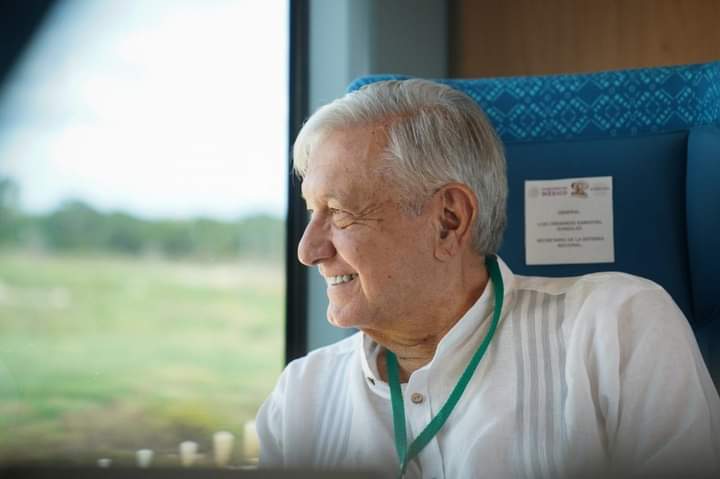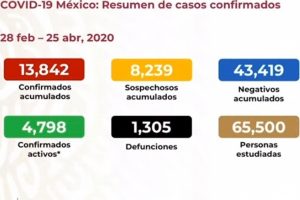
(Redaction)
This belongs to the people, and we are all going to take care of it, says the president after thanking workers, companies and authorities. It’s public investment; we don’t owe anything
Everything is ready to offer passenger service from Campeche to Cancun starting tomorrow, December 16. The Maya Train Director General announces the pre-opening schedule and gives a summary of the project
More than 2,800 individuals have been trained in railway safety
The Campeche government and Mota-Engil, Carso, Azvindi, ICA and Alstom consortiums highlight the record completion time.
San Francisco de Campeche, Campeche., December 15, 2023.- President Andrés Manuel López Obrador led the inaugural run of the Maya Train today and unveiled a plaque to mark the start of operations for the first stage from Campeche to Cancun. He called it a historic day, because 1,554 km in total were built in record time.
“It is a magnum opus. We are not exaggerating if we say that there is no such public work in the world today.”
The president said that this large-scale project is the product of civil and railway engineering, but, above all, is due to the 100,000 construction workers from all over the country who participated and who represent Mexico’s comparative advantage over other nations because they are the best.
He said that the work was also completed thanks to Grupo Carso, Mota-Engil, INDI, and ICA, companies that built various sections, and to Alstom, that manufactured the trains in Ciudad Sahagún.
“We would not have been able to complete this work without the support of the Defense Ministry’s military engineers. They have been of key importance. There are no excuses, there are no pretexts, and they get the work done.
“Of course, I thank the local authorities of Tabasco, Chiapas, Campeche, Yucatán, and Quintana Roo: the ejido commissioners, who are community property presidents; private owners; and the people who live where the train runs, who helped us a lot.”
He emphasized that there are no public works projects like this in the world with the costs of the Mayan Train, which will be announced in due course, and added:
“It wasn’t a loan, it was public investment. We owe nothing for the Maya Train, nothing. This belongs to the people of Mexico and that is why we are all going to take care of it. It is a work belonging to all Mexicans to greatly help with the development of the southeast.”
He said that the first stage has already fulfilled the purpose of creating many jobs in the southeast, because public works reactivate the economy, as can be demonstrated by the double-digit growth rates in the region.
“For the first time in many years, poverty was reduced in Mexico and where poverty was reduced the most was in the southeast. That is why we should feel very proud, very happy, and that is why I say that this is a very special day for the southeast, for Campeche, and for Mexico.”
He added that the Maya Train will communicate the ancient Mayan cities and noted that tourism will spearhead development in southeastern Mexico, which is a paradise due to its cultural heritage, unparalleled flora and fauna, beaches in the Gulf of Mexico and the hospitality of its towns, which is why he anticipates that the region will attract income and create jobs for several generations.
“We are going to ensure that the costs are not excessive, because foreign tourists are important. Of course, we have to do a good job with it, because tourism is an activity that creates wealth, but its advantage is that the wealth is distributed, because it isn’t just about the tourist. Hoteliers, restaurateurs, and workers, many workers, live of it, as do those in transportation, and business and, of course, tourism professionals. So, yes, international tourism is considered, but also national tourism, and we are going to ensure that there are no high costs.
“We have already agreed with General Águila that the train fare will always be lower than bus fare, even if just by a little, for Mexicans, for the people from Campeche, Tabasco, Sonora, and Guerrero, and for those who want to come. And they are putting together packages, for the train, airports, and hotels.”
Accompanied by Cabinet members and representatives of the companies involved, the president unveiled the inaugural plaque:
“The government of the Republic inaugurates the Campeche-Cancún section of the Maya Train project, a railway project in which construction workers, technicians and national and foreign companies participated, in addition to the Mota-Engil, Grupo Carso, Azvindi, ICA and Alstom construction companies.
‘This flagship project will promote economic development and tourism in the southeastern region of the country for the benefit of the people of Mexico.
‘San Francisco de Campeche, Campeche, December 15, 2023.’
The Secretary of National Defense, Luis Cresencio Sandoval González, said that, in accordance with the Organic Law of the Mexican Army and Air Force, they fulfill the mission of carrying out social works to contribute to the country’s progress.
For this reason, he said that the Mexican Army Engineer Corps is involved in works such as the Banco del Bienestar branches; construction of the ‘Felipe Ángeles’ and ‘Felipe Carrillo Puerto’ international airports; modernization of the Chetumal airport; irrigation and aqueduct infrastructure; customs modernization; and construction of Sections 5 North, and 6 and 7 of the Maya Train.
The deadline was met; love for Mexico and passion for the project overcame obstacles: Lozano
The deadline was met and, despite obstacles that were overcome with teamwork, preparation and, above all, love for Mexico and deep passion for the project, the Maya Train now begins its pre-opening as planned and is ready to provide safe, compfortable and efficient passenger service starting tomorrow, December 16, the project’s Director General Óscar David Lozano Águila said today.
At President López Obrador’s morning press conference, Director General Lozano Águila reported on the project’s conclusion and the start of the pre-opening of the passenger service from San Francisco de Campeche to the Cancún Airport, a route of 473 kilometers.
He explained that starting tomorrow, December 16, two trains will depart at 7:00 a.m. and 11:00 a.m. daily, from San Francisco de Campeche and Cancún simultaneously. “This service may be modified during the pre-opening stage and, naturally, there will be adjustments to the train’s operation and speed.»
In his summary of the project, he discussed the work done by various government entities and private companies, both national and foreign. However, he stressed that “the true strength of the Maya Train lies in its people, in the titanic effort of the Mexicans who collaborated daily and who brought talent and creativity” to the project.
He said that the sustained effort of almost five years has aimed to comply with environmental regulations, preserve the archaeological heritage of the Mayan culture and recover its splendor; reorganize spaces and work to connect a wealth of tourist sites and communities that will enrich the visitors’ experience and harmoniously integrate economic development opportunities for local families.
“We are only fulfilling the first major task of our mission, which is to begin operations on the San Francisco de Campeche-Cancún route, which connects 14 stations for the benefit of millions of visitors and the local population of Campeche, Yucatán and Quintana Roo.”
Project summary
He reported that the work done includes the installation of 1,846 km of rails; 1.6 million sleepers; the operation of 7,550 machines, 3,620 km of pipelines; thousands of welds and more than 69 million m3 of earth to build the railway through Campeche, Yucatán and Quintana Roo.
He said that the works along the 473 km consist of 14 stations, two depots in Teya and Hampolol, Campeche; two maintenance bases in Teya and Valladolid; a workshop and garage in Cancun; 187 cross drainage works; and 362 vehicular, general, pedestrian and wildlife crossings. More than 100,000 jobs were created.
Archaeological zones
As part of the Archaeological Zone Improvement Program (Promeza), the National Institute of Anthropology and History (INAH) recovered 12 archaeological zones along the route and five Visitor Centers (Catvi) were built.
Recovering the archaeological heritage along this section has involved the work of hundreds of archaeologists, anthropologists, specialists and workers who recovered 13,801 properties, 624,522 ceramic fragments and 427 natural features.
Environment
As part of the Maya Train environmental commitment, there are 510,690 hectares of Protected Natural Areas along its route. Thanks to the underground and surface water monitoring programs and the program to mitigate and prevent ecological damage and risks, the entire hydrological system of the cenote ring can be conserved.
In addition, there will be a new Protected Natural Area, the “Nuevo Uxmal” Park, with an area of 2,000 hectares, located between the states of Yucatán and Campeche.
Complementary works
He reported that the Maya Train project included the construction of works such as the “La Plancha” Park, which was inaugurated on November 19 and is already being enjoyed in Mérida, and the IE-TRAM project that connects the park with the Maya Train Mérida Teya and Umán stations.
He highlighted the electric transportation system that connects the San Francisco de Campeche station with the Historic Center of Campeche, and construction of the “New Uxmal” Park and the Maya Train hotels in Uxmal and Chichén Itzá.
Comprehensive Development Plan
He reported that specific social actions were carried out in the towns along the train’s route, which benefited communities in Campeche, Yucatán and Quintana Roo with 375 public works, 4,081 construction and housing improvement actions, and 83 works due to social commitments.
He announced the start next year of a program that will have the support of the Infrastructure, Communications and Transportation Ministry (SICT) to repair roads that have been used by trucks and construction machinery, for the benefit of the communities through which they pass.
Professional training
He said that the Maya Train has filled its ranks with professionals from various specialties, and graduates of educational and technical institutions, which has allowed for the creation of new specialties such as railway engineering and technical careers in railway transportation.
“The Maya Train has involved our youths: more than 80 percent of our professionals are between 21 and 30 years old; 211 are from the Yucatan Peninsula and 310 from the rest of the country; there are 84 graduates from the National Polytechnic Institute (IPN) and the National College of Professional Education (Conalep), as well as from other national educational institutions.”
Trained personnel
He reported that the Maya Train has personnel trained for the start of operations and has the support of professionals from other countries. He specified that there are currently 20 train operators, three trainers, 30 people responsible for railway operations, and technical personnel; all of them certified by the Railway Transport Regulatory Agency.
Safety
He said that safety is a priority on the Maya Train. The Defense Ministry (Sedena) has more than 2,800 individuals fully trained in railway security, and this is backed up by equipment such as drones, security cameras, radio patrols and Agusta helicopters.
Campeche Governor Layda Sansores San Román said the Maya Train is the world’s most important and iconic public work, and the most important in the history of the southeast. It is a celebration for those who have fought for years for Mexico to undergo deep transformations.
Consortiums
Mota-Engil Latin America President and Executive Director Joao Pedro Parreira said the Maya Train route of 1,554 km covers a distance equal to the distance between Lisbon and Paris. He said that the segment constructed by his company includes the “La Hoya” viaduct, which he described as a work of art due to the quality of its engineering.
Grupo Carso Director General Antonio Gómez García said that the railway in his segment is finished, as are the 193 works that include drainage and crossings for wildlife, livestock, pedestrians and vehicles, and the Tenabo and Hecelchakán Stations.
Azvindi Ferroviario Director General Manuel Muñozcano Castro said that Section 3, made up of 160 km. from Calkiní, Campeche, to Izamal, Yucatán, was one hundred percent complete. He thanked the President for including the company in the Maya Train project and commended the construction workers who made the work possible.
Empresas ICA Director General Guadalupe Phillips Margain, responsible for section 4 from Izamal to Cancún, highlighted the intensity of the work done to complete the 478 km of railroad and the 200 km of the Mérida-Cancún highway in the record time of three years. She said that, in the company’s 76 years of history, this is the only project that has been done in such a short time.
Alstom México Director Maite Ramos Gómez said that the Maya Train is a historic project, and that Mexico and the President showed the world that, with teamwork, the impossible can be done. She said that the Maya Train is the first to be manufactured in such a short time.
More information:
Transcript. Press conference headed by President Andrés Manuel López Obrador in Campeche https://bit.ly/4ahHHi5
Download The Complete Guide to the Maya Train https://bit.ly/41rWGC3



